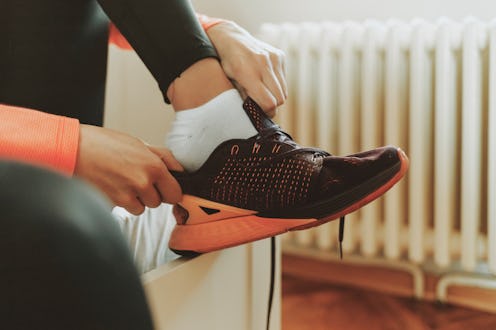Life
Science Says You Should Really Take Off Your Shoes

I hate to be the bearer of bad news, but it looks like a shoe-free home might be the only way to go. Several studies examining the bacteria that lives on and in shoes revealed why you should never wear shoes at home. I hate unlacing my shoes unnecessarily as much as the next person, and I used to think people who kept their shoes off were neurotic clean freaks. I dreaded going to parties where they make you remove your shoes before entering. My boots or heels are part of my outfit, and when I am forced to remove them, my socks most likely won’t match or my stockings will definitely have holes in them (my big toe poking out like an unwelcome guest).
While I take off my shoes in my own home, that is purely due to laziness. Removing my dirty shoes equals less mopping and vacuuming of floors for me later. In addition, it makes it easier to do the Risky Business sock slide down my hallway. But all that mud and slush that you drag in your door might not just be a cleaning nightmare. According to science, that dirt from your shoes might actually be dangerous. A study performed by Dr. Charles Gerba, of the University of Arizona, found high levels of bacteria living on shoes — 421,000 units to be exact.
In the study, ten participants wore new shoes for two weeks. The bottom and the interior of the shoes were sampled to reveal nine different bacterial strains. Some of these unpleasant guests included: “Escherichia coli, known to cause intestinal and urinary tract infections, meningitis and diarrheal disease; Klebsiella pneumonia, a common source for wound and bloodstream infections as well as pneumonia; and Serratia ficaria, a rare cause of infections in the respiratory tract and wounds.” Think of all this tracked on to the floor of your home, and you will never feel comfortable using the five second rule again.
The E. Coli strain of bacteria was most frequently found on shoes which Gerba explains “indicates frequent contact with fecal material, which most likely originates from floors in public restrooms or contact with animal fecal material outdoors." We’ve all had the misfortune of stepping in dog excrement and tracking it into our house and car. Usually, we think of it as a smelly bother, instead of worrying about the microbes hidden within. And though unpleasant, we use public restrooms frequently whether in bars and restaurants, or libraries and movie theaters. However, according to a study published in the journal of Applied and Environmental Microbiology , even if the bathroom seems clean— it most definitely isn’t.
In the study, researchers examined four bathrooms at San Diego State University. The restrooms were thoroughly sterilized, and then were put back into use. Researchers swabbed everything from the soap dispensers, to the floors and toilet seats hourly. The results were shocking, as NPR describes, “Within one hour of sterilization, the bathrooms were completely recolonized with microbes — just as plants rapidly arrive and populate a newly emerged island.” And of the 77,000 different strains, Staphylococcus was the most dominant. These MRSA-associated genes were found on the bathroom floors, and the hardy bacteria remained at stable levels for weeks and months. Yuck.
The take-away is simple. Kick off your kicks when you enter the house. And PLEASE do not eat off the floor— that’s why tables were invented. Eating that chip that fell on your carpet certainly isn’t worth a chance of MRSA. And if you want to be extra cautious, just toss your shoes in a washing machine with some detergent; a twelve minute cycle does the trick. Now, excuse me while I go buy some matching socks.
Images: PixelsEffect/E+/Getty Images, giphy